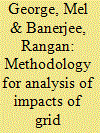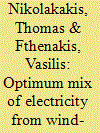| Srl | Item |
| 1 |
ID:
103386


|
|
|
|
|
| Publication |
2011.
|
| Summary/Abstract |
Present electricity grids are predominantly thermal (coal, gas) and hydro based. Conventional power planning involves hydro-thermal scheduling and merit order dispatch. In the future, modern renewables (hydro, solar and biomass) are likely to have a significant share in the power sector. This paper presents a method to analyse the impacts of renewables in the electricity grid. A load duration curve based approach has been developed. Renewable energy sources have been treated as negative loads to obtain a modified load duration curve from which capacity savings in terms of base and peak load generation can be computed. The methodology is illustrated for solar, wind and biomass power for Tamil Nadu (a state in India). The trade-offs and interaction between renewable sources are analysed. The impacts on capacity savings by varying the wind regime have also been shown. Scenarios for 2021-22 have been constructed to illustrate the methodology proposed. This technique can be useful for power planners for an analysis of renewables in future electricity grids.
|
|
|
|
|
|
|
|
|
|
|
|
|
|
|
|
| 2 |
ID:
110372


|
|
|
|
|
| Publication |
2011.
|
| Summary/Abstract |
Several countries and states have set targets for substantially increasing renewable energy (RE) contributions in their electricity grids. As the potential for additional hydro-electricity is limited in the US most future RE penetration is envisioned to be in the form of wind and solar. Our simulations, based on hourly resource and load data, demonstrate the maximum penetration achievable in the grid managed by the New York Independent System Operator (NYISO), by wind- and solar-power independently, and when they are combined. By optimizing the synergy between these two intermittent resources, a maximum penetration of renewable-energy in the grid can be accomplished; this is shown for different scenarios of grid flexibility. For example, for an 80% flexible grid, a total penetration of 30% of wind and solar energy can be achieved in the NY state without adding storage and without having to dump more than 3% energy, whereas if this was to be met by wind alone, 12% of energy would have to be dumped. Considering that several US states and countries have high targets for renewable energy penetration, optimizing the mixture of RE to accomplish such goals is valuable for energy managing and planning.
|
|
|
|
|
|
|
|
|
|
|
|
|
|
|
|
| 3 |
ID:
112240


|
|
|
|
|
| Publication |
2012.
|
| Summary/Abstract |
Variable renewable energy (VRE) generation from wind and sun is growing quickly in Europe. Already today, VRE's power contribution is at times close to the total demand in some regions with severe consequences for the remainder of the power system. Grid extensions are necessary for the physical integration of VRE, i.e., for power transports, but they also have important economic consequences for all power system participants.
We employ a regional, power system model to examine the role of grid extensions for the market effects of VRE in Europe. We derive cost-optimal macroscopic transmission grid extensions for the projected wind and solar capacities in Europe in 2020 and characterize their effects on the power system with high regional and technological resolution.
Without grid extensions, lower electricity prices, new price dynamics and reduced full load hours for conventional generation technologies result in proximity to high VRE capacities. This leads to substantial changes in the projected achievable revenues of utilities. Grid extensions partially alleviate and redistribute these effects, mainly for the benefit of baseload and the VRE technologies themselves.
|
|
|
|
|
|
|
|
|
|
|
|
|
|
|
|